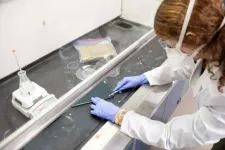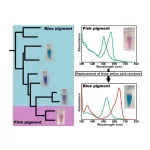The researchers will present their results at the fall meeting of the American Chemical Society (ACS). ACS Fall 2024 is a hybrid meeting being held virtually and in person Aug. 18-22; it features about 10,000 presentations on a range of science topics.
“These old books with toxic dyes may be in universities, public libraries and private collections,” says Abigail Hoermann, an undergraduate studying chemistry at Lipscomb University. Users can be put at risk if pigments from the cloth covers rub onto their hands or become airborne and are inhaled. “So, we want to find a way to make it easy for everyone to be able to find what their exposure is to these books, and how to safely store them.” Hoermann, recent graduate Jafer Aljorani, and undergraduate Leila Ais have been conducting the study with Joseph Weinstein-Webb, an assistant chemistry professor at Lipscomb.
The study began after Lipscomb librarians Jan Cohu and Michaela Rutledge approached the university’s chemistry department to test brilliantly colored 19th- and early-20th-century fabric-covered books from the school’s Beaman Library. Weinstein-Webb was intrigued to hear about how the Winterthur Museum, Garden & Library had previously examined its own 19th-century books for the presence of an arsenic compound known as copper acetoarsenite. This emerald-green pigment was used in Victorian era wallpaper, garments and — as Winterthur found out — in cloth book covers. This discovery led to the launch of the Poison Book Project, a crowdsourced research effort that uses X-ray fluorescence (XRF), Raman spectroscopy and other techniques to reveal toxic pigments in books around the world. Weinstein-Webb and the Lipscomb students he recruited launched their own investigation in 2022.
For the Lipscomb book project, the team used three spectroscopic techniques:
XRF to qualitatively check whether arsenic or other heavy metals were present in any of the book covers. Inductively coupled plasma optical emission spectroscopy (ICP-OES) to determine the concentration of those metals. X-ray diffraction (XRD) to identify the pigment molecules that contain those metals. Although XRD has been previously used to examine paintings and wallpaper, this is the first time it has been used to check for poison in books, Ais says. The XRD testing is being done in collaboration with Janet Macdonald at Vanderbilt University.
Recently, the researchers used XRF data to show that lead and chromium were present in some of the Lipscomb books. To quantify the amounts, they snipped samples roughly the size of a small paperclip from the cloth covers and then dissolved them in nitric acid. Their analysis by ICP-OES showed that lead and chromium were both present at high levels in some samples. Subsequent XRD testing indicated that in some instances these heavy metals were in the form of lead(II) chromate, one of the compounds that contributes to the chrome yellow pigment favored by Vincent van Gogh in his sunflower paintings.
However, there was far more lead than chromium in the book covers, which is somewhat mystifying, since lead(II) chromate contains equal amounts of lead and chromium. The researchers speculate that the dyes used to color the books contain other lead-based pigments that lack chromium, such as lead(II) oxide or lead(II) sulfide. The team is working to identify those other compounds in the yellow pigments.
Weinstein-Webb and the students also wanted to find out whether the levels of heavy metals in the Lipscomb books could be harmful for librarians who might handle them. For some of the book covers, the researchers discovered metal concentrations above acceptable limits for chronic exposure, according to standards set by the Centers for Disease Control and Prevention (CDC). In the dissolved sample from the most contaminated cover, the lead concentration was more than twice the CDC limit, and the chromium concentration was almost six times the limit. Chronic exposure to inhaled lead or chromium could lead to health effects such as cancer, lung damage or fertility issues.
“I find it fascinating to know what previous generations thought was safe, and then we learn, oh, actually, that might not have been a great idea to use these brilliant dyes,” Weinstein-Webb says.
The findings led the Lipscomb library to seal colorful 19th-century books that have not yet been tested in plastic zip-close bags for handling and storage. Meanwhile, books confirmed to contain dangerous dyes have also been sealed in bags and removed from public circulation.
Once the researchers have done some more testing, they plan to contribute their results to the Poison Book Project and to help spread awareness on safe handling, conservation and storage of these books among librarians and collectors.
They also hope others will follow their lead and begin using XRD, because it doesn’t require investigators to cut samples from books. “Moving forward,” says Hoermann, “we want libraries to be able to test their collections without destroying them.”
The research was supported by funds from Lipscomb University’s chemistry department.
Visit the ACS Fall 2024 program to learn more about this presentation, “Multimodal detection of toxic metals in Victorian era book cloths as part of the Beaman library collection,” and other science presentations.
###
The American Chemical Society (ACS) is a nonprofit organization chartered by the U.S. Congress. ACS’ mission is to advance the broader chemistry enterprise and its practitioners for the benefit of Earth and all its people. The Society is a global leader in promoting excellence in science education and providing access to chemistry-related information and research through its multiple research solutions, peer-reviewed journals, scientific conferences, eBooks and weekly news periodical Chemical & Engineering News. ACS journals are among the most cited, most trusted and most read within the scientific literature; however, ACS itself does not conduct chemical research. As a leader in scientific information solutions, its CAS division partners with global innovators to accelerate breakthroughs by curating, connecting and analyzing the world’s scientific knowledge. ACS’ main offices are in Washington, D.C., and Columbus, Ohio.
Registered journalists can subscribe to the ACS journalist news portal on EurekAlert! to access embargoed and public science press releases. For media inquiries, contact newsroom@acs.org.
Note to journalists: Please report that this research was presented at a meeting of the American Chemical Society. ACS does not conduct research, but publishes and publicizes peer-reviewed scientific studies.
Follow us: X, formerly Twitter | Facebook | LinkedIn | Instagram
Title
Multimodal detection of toxic metals in Victorian era book cloths as part of the Beaman library collection
Abstract
In the nineteenth century, textile manufacturing during the Victorian Era involved usage of heavy metals and carcinogenic amines in the production of book-cloth case bindings, posing potential risks to both environment and biological health. These fabrics encompass a range of vivid hues; the highly toxic pigment emerald green (copper acetoarsenite), non-arsenical chrome yellow (lead (II) chromate PbCrO4), or a mixture of Prussian blue (hydrated iron hexacyanoferrate complex Fe4[Fe(CN)6]3 . x H2O). Utilizing inductively coupled plasma–optical emission spectroscopy (ICP-OES) and portable X-ray fluorescence (pXRF), preliminary research has revealed more than 100 rare circulating books containing these toxic dyes. The purpose of this study is to detect and quantify levels of arsenic, copper, chromium, lead, and manganese in local books utilizing ICP-OES and any applicable optical modality. In the end, we hope to contribute to the larger Winterthur Project. Through this, elevated levels of harmful metals, specifically lead (II) chromate, were confirmed within the Beaman Library collection via ICP-OES.
END






